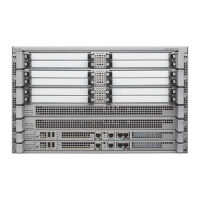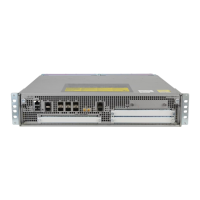Using loopback Commands
With the loopback test, you can detect and isolate equipment malfunctions by testing the connection between
the 4-Port Serial Interface SPA and a remote device such as a modem or a channel service unit (CSU) or a
data service unit (DSU). The loopback command places an interface in loopback mode, which enables test
packets that are generated from the ping command to loop through a remote device or compact serial cable.
If the packets complete the loop, the connection is good. If not, you can isolate a fault to the remote device
or compact serial cable in the path of the loopback test.
You must configure a clock rate on the port before performing a loopback test. However, if no cable is
attached to the port, the port is administratively up, and the port is in loopback mode; you do not have to
configure a clock rate on the port before performing a loopback test.
Note
Depending on the mode of the port, issuing the loopback command checks the following path:
•
When no compact serial cable is attached to the 4-Port Serial Interface SPA port, or if a data
communication equipment (DCE) cable is attached to a port that is configured as line protocol up, the
loopback command tests the path between the network processing engine and the interface port only
(without leaving the network processing engine and port adapter).
•
When a data terminal equipment (DTE) cable is attached to the port, the loopback command tests the
path between the network processing engine and the near (network processing engine) side of the DSU
or modem to test the 4-Port Serial Interface SPA and compact serial cable. (The X.21 DTE interface
cable does not support this loopback test.)
The X.21 interface definition does not include a loopback definition. On the 4-Port Serial Interface SPA,
the X.21 DTE interface does not support the loopback function. Because of the internal clock signal present
on the 4-Port Serial Interface SPAs, loopback will function on an X.21 DCE interface.
Note
Specifying the Interface Address on a SPA
SPA interface ports begin numbering with “0” from left to right. Single-port SPAs use only the port number
0. To configure or monitor SPA interfaces, you need to specify the physical location of the SIP, SPA, and
interface in the CLI. The interface address format is slot/subslot/port, where:
• slot—Specifies the chassis slot number in the Cisco ASR 1000 Series Router where the SIP is installed.
• subslot—Specifies the secondary slot of the SIP where the SPA is installed.
• port—Specifies the number of the individual interface port on a SPA.
The following example shows how to specify the first interface (0) on a SPA installed in the first subslot of
a SIP (0) installed in chassis slot 2:
Router(config)# interface serial 2/0/0
For more information about identifying slots and subslots, see the “Identifying Slots and Subslots for the SIPs
and SPAs” section in the Configuring the SIP chapter.
Cisco ASR 1000 Series Aggregation Services Routers SIP and SPA Software Configuration Guide, Cisco IOS
XE Everest 16.5
282 OL-14127-17
Configuring the 4-Port Serial Interface SPA
Specifying the Interface Address on a SPA

